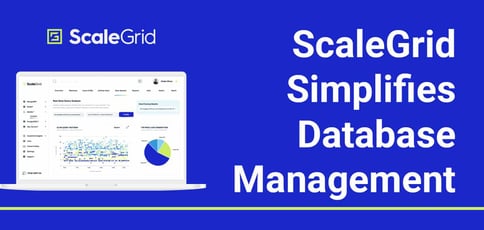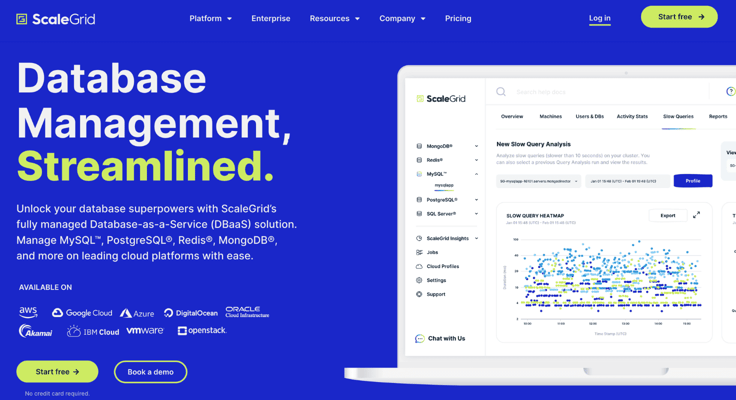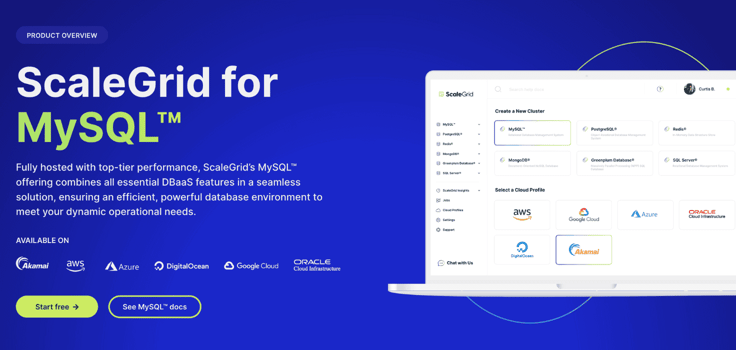
TL; DR: ScaleGrid is a Database-as-a-Service platform that helps developers, startups, and enterprises simplify their database management. Users can leverage ScaleGrid on-premises or in the cloud for various databases, including MySQL, PostgreSQL, Redis, and MongoDB. ScaleGrid uses automation to streamline management and enable teams to manage their databases with only a few clicks. We spoke with Chris Miller, CEO of ScaleGrid, about the platform and its features.
People spend 70% of all digital media time in the U.S. on mobile apps, according to BuildFire, a mobile app development platform. Unsurprisingly, the rise of app culture can be traced back to the introduction of smartphones. Since then, apps and mobile phones have become inextricably linked, two peas in a pod. You can’t have one without the other.
The evolution of applications has also been a sight to see. Modern apps have way more functionality and features than their predecessors. They have also exploded in volume. Here’s some context: In 2008, the iOS store had 500 apps. Today, more than 4 million apps exist across iOS and Android platforms. An incredible figure, right?
But with the rise of applications has come more data, and managing that data can be a hassle for developers. If developers want to create more innovative and engaging apps, they need time — that won’t be wasted on backend efforts. Thankfully, the folks at ScaleGrid can help with that problem.

“The idea behind this is that the more you have to deal with the things on the back end, the less development or true innovation will happen. We’re trying to eliminate that as much as possible and shift as much of the work to the front end as possible,” said Chris Miller, CEO of ScaleGrid.
ScaleGrid is a Database-as-a-Service solution that can help companies simplify their database management. It leverages automation to eliminate common bottlenecks in the development process and accelerate backend tasks. ScaleGrid also offers fully managed cloud services for businesses seeking to offload host administration duties.
Allowing Developers to Save Time With Automation
Dharshan Rangegowda founded ScaleGrid in 2012. Since then, ScaleGrid has become a go-to resource for companies and developers seeking to simplify their database management.
“What we want to provide is simplification. We want to make it so we can help unleash development and help teams produce more solutions,” said Chris.
Whether you use MySQL, PostgreSQL, Redis, or MongoDB, ScaleGrid can help you streamline and manage your databases for optimal performance. ScaleGrid eliminates complexities by allowing teams to manage their databases with only a few clicks.

“That means automating the process of deploying it, managing and maintaining it, updating it, and then migrating and scaling it,” said Chris.
ScaleGrid’s platform works both on-premise and in cloud infrastructure. Chris told us that ScaleGrid supports all of Amazon’s local zones, so users can have greater flexibility with their infrastructure choices.
ScaleGrid can fit into any kind of setup. Users can choose to leverage its fully managed services or just integrate its solution to simplify their own management. It also has all the capabilities a company would need, from high availability and scalability to security and compliance. Users can view and manage all their databases from one centralized location with ScaleGrid.
Easily Integrates With Any Setup
The ScaleGrid team has built its solution for easy integration. It is available on multiple platforms, including AWS, Google Cloud, Azure, Akamai, and OpenStack. Users also don’t have to worry about setup and compatibility.
“We’ve taken away a lot of the roadblocks that used to exist. In fact, ScaleGrid can work both on-premise and in the cloud. You can failover from on-prem to the cloud. The idea is that we’re giving you a platform where you can use it cross-database, cross-platform, and across clouds,” said Chris.
ScaleGrid works with most setups and allows companies to integrate their applications without much complexity. Chris advised businesses to take a leap of faith in considering database management solutions like ScaleGrid because the reward is higher than the risk.

“Don’t be afraid, especially if you’re using a tool like ScaleGrid where you can switch back to something else. Your risk is not that great, and the upside is tremendous in terms of the amount of time that you can shift from focusing on database management to focusing on the thing that brings you the most benefit,” said Chris.
Chris suggested new users should separate their applications and choose one application to migrate first, whether mission-critical or not. That way, users can learn how to use ScaleGrid and build their processes around it before migrating everything.
“You’re going to need the experience of using those tools for a period of time. I generally suggest that people take the application they’re most reliant on and move it because that’s the one that will teach you the most about it. Then you can slowly migrate the other things over time,” said Chris.
Scale Up or Down Without Hesitation
Only ScaleGrid’s fully managed solution provides autoscaling to customers. But soon enough, customers will also have autoscaling for their Bring Your Own Device (BYOD) environments. Chris told us the ScaleGrid team is working on a new platform to allow users to leverage the full capabilities of scaling within their own workspaces.
“We try to maintain a sense of we’re a tool. We provide a service, but we’re a tool first and foremost. There are customers who use ScaleGrid without the service part. They manage their own databases, but they use our tool to do 95% of the one-click tasks that you want to do with the database,” said Chris.
This new solution will enable teams to scale cloud instances whenever and wherever they need to. Chris said it will be the first solution of its kind to allow autoscaling outside a vendor’s unique offering. ScaleGrid also has new support on the way.
“We’re going to support a data plane called RabbitMQ. RabbitMQ is a message queue layer. It’s different, but we’re supporting it in an incredibly enterprise-scalable way. It’ll be able to do cross-region,” said Chris.
Besides those updates, ScaleGrid is also monitoring new data center support. Chris said the team built the ScaleGrid platform fundamentally at such a deep level that it can support data centers almost natively. If a customer wants a new region, the team can test it. You can check out ScaleGrid’s enterprise solutions, as well as their 30-day free trial period for new users to test out their database management solutions first-hand.
“When a data center comes up, we support it. We often won’t put it up because we’re waiting for a customer to demand it because it still requires UI code changes,” said Chris.


